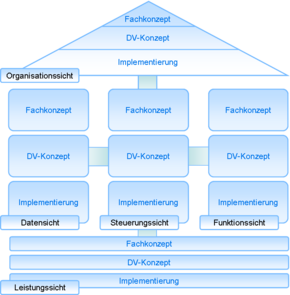ARIS
The ARIS concept ( Ar chitecture integrated I nformation s ystems ) by August-Wilhelm Scheer (formerly. Institute for Economics computer science at the University of Saarland ) to reach that operational information system 's requirements can satisfy in full.
This framework is based on a division of the model into description views and levels, which enables a description of the individual elements using specially provided methods without having to include the entire model. The methodology serves as a procedural model for mapping and optimizing business processes. These processes are mapped for each description view, starting with the business issue through to implementation at the IT level.
Description views
ARIS is mainly based on its own five-view architecture (ARIS house). These five views are the organization, data, performance, function and control view of a process. The division is made in order to break down the complexity of the model into five facets and thus to make process modeling easier.
Each view of the ARIS concept reflects the model of a business process under a certain aspect:
- Function view : The processes and the groupings and hierarchical relationships between them are described in the function view, for example in a function tree . The terms process and activity are used synonymously. Since functions support goals and are controlled by them, goals are also assigned to the function view.
- Organizational view : all resources (human workers, machines, hardware), that is, all organizational units and their relationships, see also organizational chart
- Data view: All events (which generate data) and environmental data, such as correspondence, documents, etc., i.e. all company-relevant information objects, see also Entity-Relationship Model
- Performance summary : All services, property and financial services, see product tree
- Process view (formerly control view): Integration of the previous views in a time-logical flow plan, for example in the form of an event- controlled process chain or BPMN
Description levels
Each description view of the ARIS house is divided into three description levels: technical concept, data processing concept (= DP concept, IV concept) and implementation level:
- Technical concept
- Structured representation of the business processes using description models that are understandable for the technical side (depending on the point of view, e.g .: ERM , EPK , organizational chart , function tree )
- DV concept
- Implementation of the technical concept in IT- related description models (depending on the perspective, e.g. relations , structograms , topologies )
- Implementation level
- IT-technical implementation of the described process parts (depending on the point of view, e.g. by creating program code , database systems , use of protocols )
Dissemination and related work
The ARIS concept forms the basis of various software products, for example the ARIS Toolset from Software AG , which has been the owner of ARIS trademarks since the takeover of IDS Scheer AG . At the end of 2004, part of the concept was reflected in the graphic process integration of the SAP Exchange Infrastructure .
ARIS is a very well-known approach for describing information system architectures, especially in German-speaking countries. As a concept of the Group Management Frameworks , however, it is one of over fifty frameworks for information management that exist on the market.
With the “Model-to-Execute” approach, business processes can be modeled in ARIS and automatically transferred to webMethods BPM for technical execution .
literature
- Jörg Krüger, Christian Uhlig: Practice of business process modeling - use ARIS successfully. VDE-Verlag, Berlin 2009, ISBN 978-3-8007-3122-0 .
- Dirk Matthes: Enterprise Architecture Frameworks Compendium: Over 50 frameworks for IT management . 2011th edition. Springer Science + Business Media, 2011, ISBN 978-3-642-12954-4 .
- Thomas Allweyer: Business Process Management. W3L, Bochum 2005, ISBN 3-937137-11-4 .
- Rob Davis, Eric Brabaender: ARIS Design Platform: Getting Started with BPM. Springer, London 2007, ISBN 1-84628-612-3 .
- Rob Davis: ARIS Design Platform: Advanced Process Modeling and Administration. Springer, London 2008, ISBN 978-1-84800-110-7 .
- Peter Stahlknecht, Ulrich Hasenkamp: Introduction to business informatics. 11th edition. Springer, Berlin 2005, ISBN 3-540-01183-8 .
- August-Wilhelm Scheer: Architecture of Integrated Information Systems. Springer, Berlin 1992, ISBN 3-540-55401-7 .
- August-Wilhelm Scheer, Wolfram Jost: ARIS in practice. Springer, Berlin 2002, ISBN 3-540-43029-6 .
Web links
- Article on ARIS in the encyclopedia of business informatics
- Instructional videos for ARIS modeling Research group wi-mobile, University of Augsburg
- ARIS Community official user community
- ARIS user forum
- ARIS in schools
- ARIS as one of over fifty concepts within the framework map (PDF; 504 kB)
Individual evidence
- ↑ Dirk Matthes: Enterprise Architecture Frameworks Compendium: Over 50 frameworks for IT management . 2011th edition. Springer Science + Business Media, 2011, ISBN 978-3-642-12954-4 , pp. 44 .
- ^ Software AG (Ed.): ARIS Platform; Release 7.2 . 2011, p. 15–19 ( softwareag.com [PDF; 3.9 MB ; accessed on July 2, 2013]).
- ↑ Dirk Matthes: Enterprise Architecture Frameworks Compendium: Over 50 frameworks for IT management . 2011th edition. Springer Science + Business Media, Berlin and Heidelberg 2011, ISBN 978-3-642-12954-4 , p. 72-77 .
- ^ Model-to-Execute - How It Works. In: softwareag.com. Retrieved January 19, 2014 .
